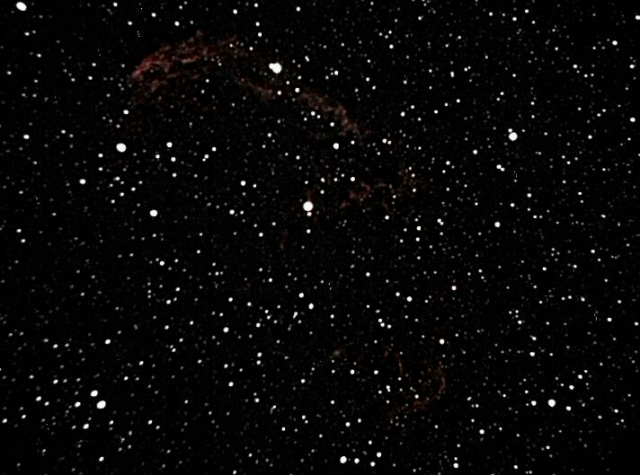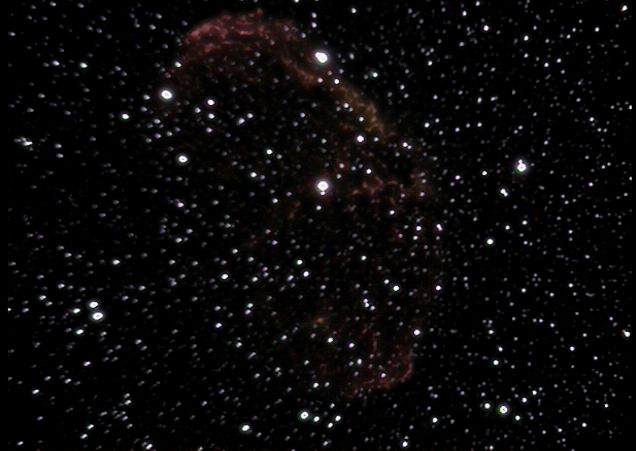

NGC6888, in the constellation of Cygnus, is an emission nebula powered by the bright star near its centre. This picture shows only the brightest part of the whole nebula.
I've had two attempts to image this nebula. In each case clouds intervened. On the first night, I knew clouds were coming so I took only 5 frames for Luminance, Hα, and OIII, but clouds prevented any pictures with SII. Two nights later skies were clear and I captured ten frames for luminance and ten for Hα but high cloud washed out the fainter wavelengths. Three nights later it was clear again and I captures ten frames at each of Hα, OIII, and SII. However, when I came to process them I realised there had been more cloud up there than I had realised and all pictures were very weak.
 |
The picture on the left is an LRGB image from the first night putting the OIII image into both the green and blue channels. Since OIII light is greeny blue, this gives a colour that approximates to what the eye would see if it were sensitive to such low-level light. Move your mouse pointer over the image and see the picture obtained on the second night. For this picture I had no data for the green and blue channels, so I made them from the Hα data by reducing the gamma to 0.4 and increasing the contrast by 20%. This removed the faint nebula so that this remains red, but so do the fainter stars in the picture. Date and Time: 17th and 19th November 2011 20:39 - 21:03, and 18:07 - 18:31 UT Camera: Starlight Xpress MX716 Telescope: LX200 with 0.33 focal reducer Capture: star_mx7. 60" exposure with Astronomik CLS, Hα, and OIII filters Processing: star_mx7. Background, non-linear stretch 25. RegiStax5. All frames stacked at each wavelength. |
 |
Ten nights later, Nephele was kind to me and chased away her clouds for a few hours after sunset and I was able to capture 10 frames each through CLS, Hα, OIII, and SII filters. I have combined these in my usual way* as an LRGB false-colour image on the left. The emission from both oxygen and sulphur are weak so the nebula is predominantly red. To give a picture a little more like it might appear to the eye I have put, in the mouseover, a picture in which I have put the OIII image into both the green and the blue channels. (OIII light is blue-green so it fits naturally into both channels. Ideally I suppose I should add the SII data to the red channel, but it would make very little difference.) Date and Time: 27th November 2011 18:23 - 19:23 UT Camera: Starlight Xpress MX716 Telescope: LX200 with 0.33 focal reducer Capture: star_mx7. 60" exposure with Astronomik CLS, Hα, OIII, and SII filters Processing: star_mx7. Background, non-linear stretch 25. RegiStax6. All frames stacked at each wavelength. RegiStax5. Four pictures aligned. Photoshop. Creation of LRGB images. |
* Hα in the red, OIII in the green, and SII in the blue.
Home Back to DSOs